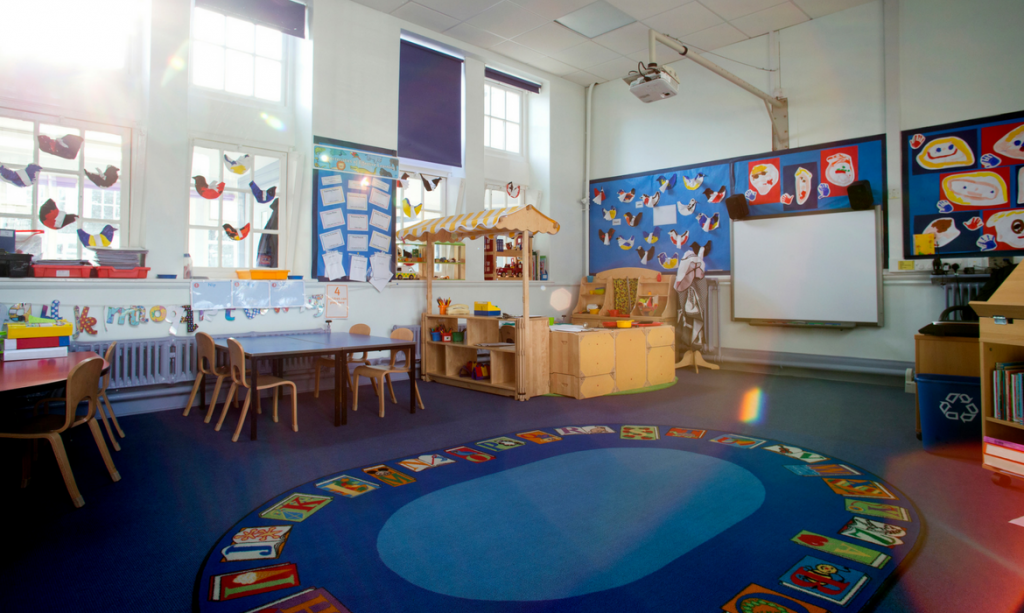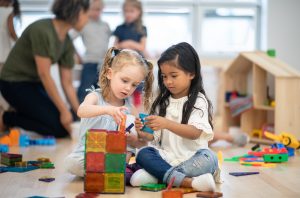It is a rare preschool that doesn’t have a daily routine of circle time, often at the beginning of the day. It provides a time for children to transition from home to school and to get settled and oriented for the day.
But how valuable is circle time? And how might teachers use it in ways that engage young children and develop their mathematical thinking?
The Preschool Day: So Much to Learn, So Little Time
The National Association for the Education of Young Children (NAEYC) encourages instruction in language, literacy, and math, as well as science and social studies. Other priorities include helping children develop fine and gross motor skills, positive personal health habits, self-regulation, and social skills. Finding time to support children’s development on all of these dimensions requires taking advantage of every minute and finding ways to get two (or more) for the price of one.
Studies suggest that circle time could be used more effectively in most classrooms. Strategies for making circle time productive are worth investigating, considering that the typical daily circle time of 15-20 minutes adds up to about 45-60 hours over a 180-day year!
Although circle time is not necessarily considered instructional, it can be used effectively to promote a wide range of competencies, including math. A study in Chicago-area preschool classrooms, for example, found that the amount of talk about math during circle time was a significant predictor of growth in children’s conventional math knowledge over the course of the school year. [1]

Calendar Time: A Circle Time Staple, but Is It Worthwhile?
A recent question about calendar time on NAEYC’s community platform, Hello, quickly became the most active thread. Consensus was that though calendar has become ingrained in daily routine, there are better ways to support children’s learning.
The NAEYC community has this right. A recent study that observed circle time in 22 public preschools reported that, after morning message, the greatest amount of time was spent on calendar. [2] Yet calendar time tends to involve rote learning, such as reciting the days of the week, the months of year, or counting the days up to the present day. Many early childhood education experts have called into question the value of such calendar activities because months and days of the week can be abstract and not very meaningful to children if not put into a familiar or significant context.
If you do calendar, make sure that the mathematics are interactive, non-rote, and connect to other concepts children are learning in the classroom. “How many days until our field trip?” “Let’s see, the sunflower seed package said that we will be able to see the sunflower plant peek out of the ground in ten days. Let’s count and mark that on the calendar!” “The first caterpillar made its chrysalis today! Let’s count how many days the caterpillar ate before it was big enough to spin a chrysalis.”

Using Circle Time to Support Early Math Learning
What are fruitful math activities to introduce while children are gathered together in a group? Below are a few suggestions.
Choose a math activity for circle time that reinforces the math concepts being worked on during instruction. Whatever the math concept, an important goal is to engage children in conversation, taking care to encourage all children to participate. One strategy for engaging more children is to ask another child or the whole group whether they agree with the child who answered a math question. You can also ask another child to explain a child’s answer. “How do you think Shana figured that out? Can anyone think of a different way?”
Number and Operations
- Ask children to count how many boys are here today, then how many girls. “How many more boys than girls are there?” “How could we figure out how many children altogether are here today?” “Jose and Mary aren’t here today. How many children would we have if they were here?”
- Have children stand in groups of four and ask them, “How many legs are in your group altogether? How many arms? How many legs AND arms? How many fingers altogether?” Ask each group to explain how they figured out the answer.
- Ask children to hold up a specific number of fingers. Encourage them to find different ways to represent that quantity on their fingers (four fingers on one hand, two fingers on each hand, three fingers on one hand and one finger on the other). Ask them how they figured out how many fingers to hold up on each hand.
- Have children vote on which of two books they would like you to read, and put a hatch mark on the board for each vote. Then ask the children to count how many votes each book got, and which book has more votes.
Patterns
- Move! Clap your hands in a rhythmic pattern and discuss the pattern. “That was three loud claps, then two soft claps.” Have children introduce patterns that others can imitate.
- Ask children to describe the pattern in a child’s clothing (e.g., “George’s shirt has stripes that go green, white, green, white.”)
Measurement
- Ask children which is longer, their legs or their arms? Ask pairs of children to compare the lengths of their legs. Ask them to take off one shoe and figure out how many shoe lengths the leg and arm of their buddy is (it is okay if it turns out to be three shoe lengths and a little more). Engage in a discussion about length. “How many more shoe lengths is your buddy’s leg than his/her arm?” “How many shoe lengths do you think the whiteboard [or some other large object in view] is?”
- Have children stand up in groups of three and figure out who is the tallest and who is the shortest or who has the longest hair and who has the shortest hair. Have half the children lie down next to each other with their feet touching the wall. Ask the other half to look closely at the line-up and decide who is the longest and the shortest. Who is the second longest? Have half the children stand in a line, close together, and have the other half move them around so they are in order of their height. (See our video, Using Bodies to Compare Size.)
Shape and Space
- Have children discuss different shapes they can see from where they are sitting. “How do we know a shape is a triangle, a square?” “Which shape has more sides?”
- Read a picture book that provides opportunities to discuss math concepts like shape and space or numbers and counting.
[1] Klibanoff, R., Levine, S., Huttenlocher, J., Vasilyeva, M., & Hedges, L. (2006). Preschool children’s mathematical knowledge: The effect of teacher “math talk.” Developmental Psychology, 42(1), 59-69.
[2] Bustamante, A., Hindman, A., Champagne, C., Wasik, B. (2018). Circle time revisited: How do preschool classrooms use this part of the day? The Elementary School Journal 118(4), 610-631.



